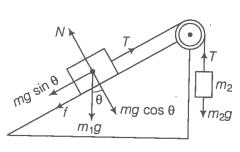Mass \(m_{1}\) moves on a slope making an angle \(\theta\) with the horizontal and is attached to mass \(m_{2}\) by a string passing over a frictionless pulley as shown in the figure. The coefficient of friction between \(m_{1}\) and the sloping surface is \(\mu\).

| (a) | If \(m_{2} > m_{1} \text{sin} \theta \), the body will move up the plane. |
| (b) | If \(m_{2} > m_{1} (\text{sin} \theta +\mu \text{cos} \theta)\), the body will move up the plane. |
| (c) | If \(m_{2} < m_{1} (\text{sin} \theta +\mu \text{cos} \theta)\), the body will move up the plane. |
| (d) | If \(m_{2} < m_{1} (\text{sin} \theta -\mu \text{cos} \theta)\), the body will move down the plane. |
| 1. | (a), (d) | 2. | (a), (c) |
| 3. | (c), (d) | 4. | (b), (d) |


© 2025 GoodEd Technologies Pvt. Ltd.